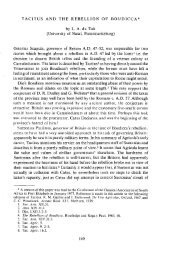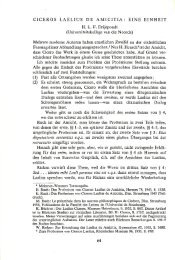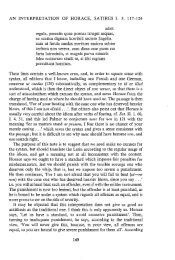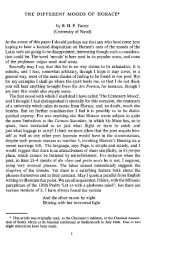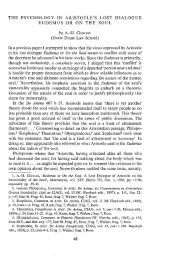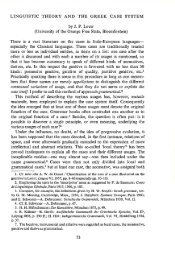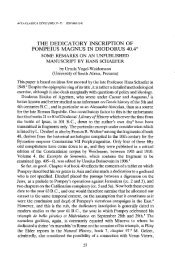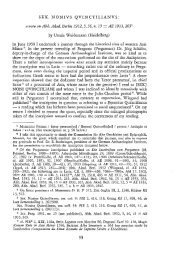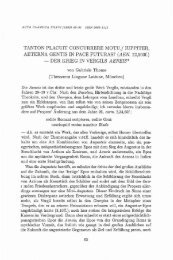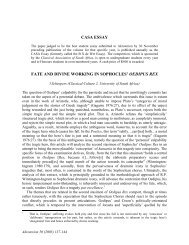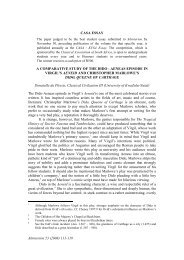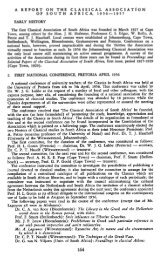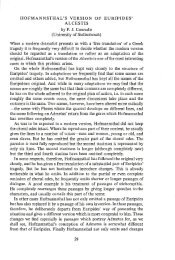as net kursoriese aandag wil gee. Daar is maar min drukfoute: genatief
as net kursoriese aandag wil gee. Daar is maar min drukfoute: genatief
as net kursoriese aandag wil gee. Daar is maar min drukfoute: genatief
Create successful ePaper yourself
Turn your PDF publications into a flip-book with our unique Google optimized e-Paper software.
<strong>as</strong> <strong>net</strong> <strong>kursoriese</strong> <strong>aandag</strong> <strong>wil</strong> <strong>gee</strong>. <strong>Daar</strong> <strong>is</strong> <strong>maar</strong> <strong>min</strong> <strong>drukfoute</strong>: <strong>genatief</strong><br />
(bl. 12), vereers (bl. 13) en godel/ike (bl. 61); <strong>maar</strong> die Griekse aksente het<br />
blykbaar verskuiwings (en 'n paar <strong>drukfoute</strong>) veroorsaak by die paar woorde<br />
wat in Grieks gedruk <strong>is</strong>. Die spelling van Kl<strong>as</strong>sieke Eie- en Plekname in<br />
Afrikaans <strong>is</strong> hela<strong>as</strong> nog onseker: d<strong>is</strong> seker daarom dat P<strong>is</strong>torius ,A<strong>is</strong>chulos'<br />
skryf en Gonin ,Dionysos'. Vir die beteken<strong>is</strong> van twee Afrikaanse (?) woorde,<br />
,awery-grosse' (bl. 45) en ,areaal' (bl. 14), kon ek W AT raadpleeg, <strong>maar</strong><br />
,bemat<strong>is</strong>te' (bl. 53) moet 'n mens, so lyk dit vir my, by Athenaeus gaan haal.<br />
Ook sou dit dalk 'n glimlag kon ontlok dat Dreyer, ter dokumentering,<br />
Dreyer aanhaal (bl. 1), en P<strong>is</strong>torius P<strong>is</strong>torius (bl. 58); en dalk ook dat la<strong>as</strong>genoemde<br />
dit nodig vind om terloops te se dat Apuleius waarskynlik swart<br />
van kleur w<strong>as</strong> (bl. 60).<br />
Maar dit <strong>is</strong> nietige puntjies die, vergeleke by die werklike verryking van<br />
ons ernstige leesstof in Afrikaans, wat met al die lesings in hierdie reeks aangebied<br />
word. Die Kl<strong>as</strong>sikus kan wel<strong>is</strong>waar meen dat <strong>net</strong> Gonin en P<strong>is</strong>torius<br />
eintlik kultuurbei:nvloeding in die Oudheid bespreek het, terwyl die ander<br />
bei:nvloeding uit die Oudheid beklemtoon het. Maar ook dit kan niks anders<br />
<strong>as</strong> wins wees nie.<br />
Universiteit van Stellenbosch<br />
J. P. J. VAN RENSBURG<br />
D. R. Beeton and others: The Purpose of Studying Literature (Communications<br />
ofthe University of South Africa, B 24; Pretoria, 1965), 53 pp.<br />
On September 4th and lith, 1965, a symposium w<strong>as</strong> held at the University<br />
of South Africa in Pretoria on The Purpose of Studying Literature. The papers<br />
delivered on th<strong>is</strong> occ<strong>as</strong>ion have now appeared in a slim volume <strong>as</strong> no. B 24<br />
in the series of Communications of the University. The papers are: Prof.<br />
J. L. Steyn, 'Die Doel van Literatuurstudie'; Prof. P. Haffter, 'Psychology<br />
and Literary Critic<strong>is</strong>m'; Mr L. H. Hugo, 'The Purpose of Studying Literature';<br />
Prof. G. v. N. Viljoen, 'Literatuurstudie in die Kl<strong>as</strong>sieke'. 'Chairman's<br />
Notes' by Prof. D. R. Beeton, and a 'Resume and Review' by Mr E. Pereira<br />
have been included.<br />
The literary principles ra<strong>is</strong>ed by the various speakers are largely common<br />
knowledge among literary critics in general. The critical writings of T. S.<br />
Eliot, D. H. Lawrence, I. A. Richards, Wellek and Warren, David Daiches,<br />
and others have brought about changes in the approach to literary art. But<br />
these principles and new techniques of literary critic<strong>is</strong>m have taken longer to<br />
leaven the critic<strong>is</strong>m of cl<strong>as</strong>sical literary works. Cl<strong>as</strong>sical scholarship would<br />
do well to consider the applicability and importance of these principles to<br />
the literatures of ancient Greece and Rome.<br />
144
Several approaches to a literary work of art emerge: the biographicalh<strong>is</strong>torical,<br />
the psychological, the descriptive, the impression<strong>is</strong>tic, and the<br />
analytical. The descriptive and impression<strong>is</strong>tic are rightly d<strong>is</strong>m<strong>is</strong>sed; the<br />
psychological offers new and interesting, if limited and qualified, uses (illu<strong>min</strong>ating<br />
an art<strong>is</strong>t's personality need not illu<strong>min</strong>ate h<strong>is</strong> work; cf. Haffter,<br />
p. 21); the remaining two are really the two opposite poles of literary critic<strong>is</strong>m,<br />
perhaps not quite irreconcilable. The biographical-h<strong>is</strong>torical approach<br />
ins<strong>is</strong>ts on a knowledge of the background of the poem, the time in which it<br />
w<strong>as</strong> written, the ·person who wrote it; the poem <strong>is</strong> a piece of documentary<br />
evidence illustrating a biographical or h<strong>is</strong>torical fact. The analytical approach<br />
ins<strong>is</strong>ts on the self-sufficiency of the work of art <strong>as</strong> an organic whole, excluding<br />
all extraneous material <strong>as</strong> irrelevant.<br />
These two approaches find expression in the papers of Prof. Steyn and<br />
Prof. Viljoen. For the former, literary critic<strong>is</strong>m aims at the study of the literary<br />
work of art <strong>as</strong> 'woordkuns' (p. 13), with prec<strong>is</strong>e, scientific analys<strong>is</strong><br />
replacing mere paraphr<strong>as</strong>ing, biographical and h<strong>is</strong>torical material around<br />
the work, and mere flighty adulation. Evaluation and understanding must<br />
rest on firmer foundations than impression<strong>is</strong>tic responses. However, Prof.<br />
Steyn rightly acknowledges the usefulness of studying h<strong>is</strong>torical development,<br />
genres and types, literary periods and movements (p. 19).<br />
Prof. Viljoen's paper stresses the importance of period and background in<br />
the cl<strong>as</strong>sical literatures (p. 41 ff.). The work of art <strong>is</strong> a product of its timethough<br />
the great work <strong>wil</strong>l transcend its time and not become dated (cf.<br />
Hugo, pp. 33-4). A poem, for example, should be sufficient in itself without<br />
biographical and h<strong>is</strong>torical material to explain it. At most th<strong>is</strong> material<br />
explains the origins of the poem rather than the poem itself (Steyn, p. 16).<br />
Th<strong>is</strong> <strong>is</strong> true also for the cl<strong>as</strong>sical literatures-with th<strong>is</strong> prov<strong>is</strong>o: the cl<strong>as</strong>sical<br />
languages have to be recreated, their 'woordkuns' resurrected, their meanings,<br />
emotions, the very feeling and aura of the words have to be red<strong>is</strong>covered<br />
(Viljoen, pp. 41f.). Th<strong>is</strong> can only be done with maximum use of background<br />
material-but then <strong>as</strong> medium and not end in itself. So, for example, it <strong>is</strong> not<br />
literary critic<strong>is</strong>m to attempt to establ<strong>is</strong>h who in reality all Horace's girlfriends<br />
were, or if indeed they were real, or whether he really loved them.<br />
Such considerations make no difference whatsoever to the reality of the<br />
poems in which they figure-and the reality of the poem itself <strong>is</strong> the concern<br />
of the literary critic (cL Viljoen, pp. 44-5).<br />
Prof. Viljoen h<strong>as</strong> justifiably touched on the need for extensive reading of<br />
the cl<strong>as</strong>sical literatures, if necessary at the expense of writing Greek and<br />
Latin prose and verse (pp. 42f.), and the need for research into the problem<br />
of imitatio and aemulatio in Latin literature (pp. 45ff.). Too often <strong>is</strong> Latin<br />
literature tied to the apron-strings of the Greek, with little regard for the<br />
deeper problem of how the Latin writers borrowed. That it w<strong>as</strong> nearly always<br />
conscious borrowing should warn us against merely quoting Greek parallels.<br />
145
The Latin writers knew those parallels-and more. So did their readers.<br />
Every important writer in Latin literature needs to be re-exa<strong>min</strong>ed and h<strong>is</strong><br />
'borrowing' compared with the 'original'. Even among Greek authors there<br />
<strong>is</strong> 'borrowing', the repeated occurrence of similar themes, images, myths.<br />
How do they compare with each other? What were the writers trying to do,<br />
what were they showing their readers? If we can answer these questions we<br />
shall have a better understanding of the creative imagination of the writers of<br />
antiquity. And a new approach to the problem of originality in both Greek<br />
and Latin writers, especially poets. Thus, when Prof. Viljoen quotes Anakreon<br />
fr. 63 (Page) alongside Horace, Carm. 1.23, without a full compar<strong>is</strong>on<br />
and analys<strong>is</strong> of both pieces, one <strong>is</strong> d<strong>is</strong>appointed. He does show how Horace<br />
in Carm. 1.23 rejects the conventional fawn-be<strong>as</strong>t of prey image and builds<br />
up a new poem (p. 48). But greater emph<strong>as</strong><strong>is</strong> on what Horace h<strong>as</strong> substituted<br />
for the conventional would have made h<strong>is</strong> d<strong>is</strong>cussion more rewarding: viz.<br />
the girl-shoot (Chloe, xMrl) image (on which cf. now M. Owen Lee, CP<br />
1965, 185 ff.-though Lee goes too far in identifying the woodland scene with<br />
Chloe herself).<br />
A modern example would perhaps not be out of place. T. S. Eliot, in h<strong>is</strong><br />
W<strong>as</strong>te Land, made copious use ofliterary allusion and borrowing, very much<br />
like a Latin poet. He then appended h<strong>is</strong> own notes to the poem, giving only<br />
references of h<strong>is</strong> sources, very much like the commentaries on cl<strong>as</strong>sical<br />
authors. But these notes are quite inadequate for an understanding of Eliot's<br />
poem. It <strong>is</strong> left to the literary critic to analyse, compare, d<strong>is</strong>cover the how<br />
and wherefore of such sources. Eliot w<strong>as</strong> obliged to append notes for h<strong>is</strong><br />
readers; the cl<strong>as</strong>sical poet could rely on h<strong>is</strong> enlightened readers to recogn<strong>is</strong>e<br />
h<strong>is</strong> sources, and make compar<strong>is</strong>ons. So, too, the cl<strong>as</strong>sical scholar who would<br />
become a literary critic of the cl<strong>as</strong>sical literatures can no longer rest at mere<br />
'Quellenforschung', at mere appending of references. He must interpret for<br />
h<strong>is</strong> time, infuse Greek and Latin literature with the life it once had, and, by<br />
recreating its relevance to antiquity, thus justify its relevance in the 20th<br />
Century.<br />
Printing and other errors are frequent: 'hal' for 'haal' (p. 15); 'Cope' for<br />
'Cape' (p. 18, n. 3); '<strong>as</strong> long scholars' for '<strong>as</strong> long <strong>as</strong> scholars' (p. 20); 'h<strong>is</strong><br />
book' for 'th<strong>is</strong> book' (otherw<strong>is</strong>e ambiguous; p. 20); 'showed the first' for<br />
'first showed' (p. 21); '<strong>as</strong>sociating himself up with' for '<strong>as</strong>sociating himself<br />
with' (p. 22); 'concret<strong>is</strong>ed' but then 'concretize' (p. 22) 'Aeneid, Part VI' for<br />
'Aeneid, Book VI' (p. 23); 'h<strong>as</strong>' for 'have' (p. 24); 'stresses' for 'tresses' (p.<br />
25); 'lement' for 'element' (p. 26); 'an creative' for 'a creative' (p. 28);<br />
'independance' for 'independence' (p. 28); 'thought' for 'though' (p. 30);<br />
'terms' for 'term' (p. 36, n. 11); 'Frankel' for 'Fraenkel' (p. 45).<br />
All in all a worthy effort, which should be emulated more frequently in<br />
th<strong>is</strong> country.<br />
University of Natal<br />
146<br />
W. J. HENDERSON
Acta Cl<strong>as</strong>sica <strong>is</strong><br />
publ<strong>is</strong>hed annually<br />
by the Cl<strong>as</strong>sical<br />
Association of<br />
South Africa.<br />
The journal h<strong>as</strong> been<br />
in production since<br />
1958. It <strong>is</strong> l<strong>is</strong>ted on<br />
both the lSI and the<br />
SAPSE l<strong>is</strong>t of<br />
approved publications.



